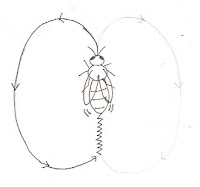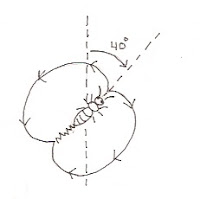Dancing Bees
It isn’t a salsa,
samba, tango or waltz, but is just as intricate. This dance is performed
repeated throughout the day in honey bees hives around the world.
The above video
shows a worker who has recently returned from a foraging trip. By the color of
the pollen on her back legs, she’s pretty excited about the patch of dandelions
she found. Her job now, as a dancer, is to give explicit directions to this
choice site. As you can see in the video, she has a few interested foragers.
The basic waggle
dance pattern follows a figure-eight circuit.
 |
| Left half of waggle dance |
Our
dancing bee starts by ‘waggling’ her abdomen back and forth and back and forth
as she runs forward. At the end of her ‘run’ she will walk around to the left
and begin the dance all over again.
 |
| Right half of waggle dance |
She will ‘run’
again in the same direction waggling her abdomen for the same amount of time.
At the end of this ‘run’ she will turn to the right and complete the figure-eight
pattern.
To keep her followers
interested, she may stop briefly to share some of the nectar she has collected.
This way her sisters know what type of flower they are looking for.
 |
| Duration to distance of waggle dances |
Believe it or not,
extensive studies have been done on deciphering the waggle dance. Basically,
the duration of the dance indicates the distance from the hive to the luscious source
of nectar/pollen. Roughly one second of waggling equals 1000 meters.
The direction and length of
the waggling (which will always be the same for the duration of the dance)
gives the exact location of the flowers in relationship to the sun. Sounds complicated?
It is.
Fortunately, honey
bees are much better at geometry than I am!
 |
| Forty degree waggle dance |
The angle that she
waggles, as opposed to going straight up, is directly related to the angle of
the sun in relation to the nectar/pollen source. The worker in the video is on about a 135 degree angle.
 |
| Honey bee navigation |
The
other foraging bees learn the dance and know exactly where they’re headed when
they leave the hive. The final key to finding that amazing patch of flowers is
scent. This they would have picked up
from sampling nectar from the bee doing the initial dance. Recruited foragers make a bee-line from the hive to the nectar/pollen source.
So much for
thinking how brilliant we are with our GPS. Honey bees have been pin-pointing
locations for thousands of years!
 |
| Foraging honey bee in alfalfa |
No comments:
Post a Comment